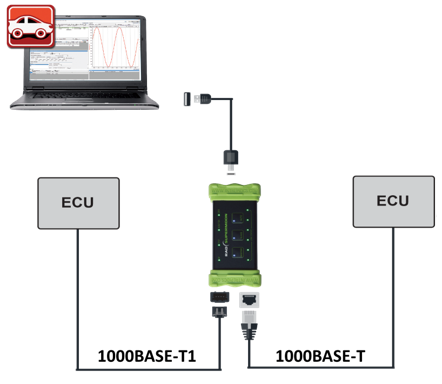2. Introduction
Thank you for purchasing Intrepid Control Systems’ RAD-SuperMoon or RAD-Moon2. You will find this a valuable tool in developing and testing 100/1000BASE-T1 networks.
The RAD-Moon2 is a Gigabit media converter between 1000BASE-T (traditional shielded 8-wire Ethernet) and 1000BASE-T1 (Automotive Unshielded Twisted Pair Ethernet) It can also be configured to support 100BASE-TX/T1 media conversion.
Note
Please note our RAD-SuperMoon is obsolote product, replacement of this product is RAD-Gigastar. For Active Network Taps information, please visit our page at https://intrepidcs.com/products/automotive-ethernet-tools/active-network-taps/
The RAD-SuperMoon has all the functionality of the RAD-Moon2, but has additional features such as an active tap mode which is essential to developing and testing 1000BASE-T1 networks.
2.1. Package Contents
Upon receipt, please remove, unwrap and inspect all its contents. If anything is missing or damaged, please contact Intrepid for prompt assistance. Contact information can be found at the end of this guide.
2.1.1. Hardware
Your package includes the following:
The RAD-SuperMoon or RAD-Moon2 device.
A standard 8-wire Ethernet cable (CAT5e)
A standard USB Type A to Type C SuperSpeed cable
A 12 Volt Power Supply (not included - purchase separately)
1000BASE-T1 cable with TE MATEnet / Rosenberger H-MTD connector (not included - purchase separately)
Optional TC10 and MACsec support (RAD-MOON2-2220M)
2.1.2. Software
Unless physical media was specifically requested, your box should contain a reference card with instructions on where to download the device drivers and any other purchased software. If your media or reference card cannot be located, please contact Customer Support.
2.2. Operational Overview
Note
The RAD-Moon2 is purely a media converter device and does not support all of the features of the RAD-SuperMoon. Features not supported by the RAD-Moon2 will be highlighted throughout this manual.
2.2.1. 1000BASE-T/T1 Media Converter
A typical application of this device is to connect an Automotive Ethernet ECU to the Ethernet port on a laptop or desktop PC.

The RAD-SuperMoon and RAD-Moon2 contain two different Ethernet physical layer implementations (PHYs) that are internally connected: a 1000BASE-T1 PHY, and a conventional 1000BASE-T Ethernet PHY. Whenever any data is received over either connection, it is automatically sent out on the other, creating a seamless link between the two attached devices. Full-duplex operation is supported, so data can be sent in both directions simultaneously.
2.2.2. 1000BASE-T1 Active Tap
RAD-SuperMoon Only
The RAD-Moon2 does not support the Active Tap feature.
Another application is to tap the communication between two 1000BASE-T1 devices. Note that a second RAD-Supermoon or RAD-Moon2 is required as shown in the diagram below.

In this configuration, your devices act as a “man in the middle”. Communication between the 2 ECUs is intercepted and a copy is sent over USB 3 to the monitoring computer at the same time forwarded to its intended destination.
2.2.3. Independent Ports
RAD-SuperMoon Only
The RAD-Moon2 does not support the Independent Port Mode.
A less frequently used mode makes the two Ethernet ports available independently to VSPY or the Intrepid Open Source APIs for transmitting and receiving Ethernet frames.

Note
In this mode, the two Ethernet ports of your device will not enumerate as network adapters on the connected computer. They are only accessible to Vehicle Spy software and the Open Source API available from Intrepid.
2.3. Hardware Requirements
2.3.1. Device Power
Your device can be powered in multiple ways.
DC supply:
This device comes with a DC supply rated for this device. If an alternate supply is used, insure that the voltage is between 5V-40V and is rated for at least 1 Amp.

Power over Ethernet (PoE)
RAD-SuperMoon Only
The RAD-Moon2 does not support PoE
Available when connected to a device certified for PoE.

Certified USB 3.0 Port:
Earlier versions or uncertified devices may not supply the current required for reliable operation. If you are unsure of your USB port’s power capabilities, use one of the other 2 options to provide power to the device.

Using older USB Ports
If using an underpowered USB port or hub, always connect the DC Supply or PoE prior to connecting the device to this hub or port. Failing to do this will not damage the device, but it has been observed that the device may not boot and function properly.
2.3.2. Computer Interface
Connection to a computer is needed both for configuration of the tool as well as to communicate with the device if you intend to use Vehicle Spy or Intrepid’s available API.
If powering by USB, it is it is important to connect to a certified USB 3 port using a USB 3.0 cable certified for SuperSpeed. Using inferior hardware and cables may result in erratic performance.
If powering by a DC supply or PoE, a USB 3 port is not absolutely necessary, however earlier versions of USB are considerably slower and may not support the bandwidth needed to tap 1000BASE-T1.